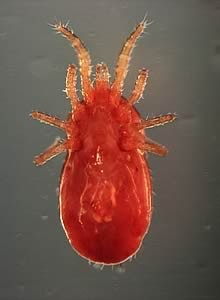How do you solve a problem like red mites? These tiny creatures wreak havoc on layer farms, and around 80% of units have had them at some time or another. Indoor, free-range, organic the infestation rate is similar across the board.
In Edinburgh this September, vets from across the world gathered for the World Veterinary Poultry Association (WVPA) Congress, and red mites were one of the hot topics up for discussion.
New treatments, ways to improve biosecurity measures, and alarming stories of farmers using unregulated products “including petrol to clean sheds“ were all shared among the experts attending.
Among those there was Dr Olivier Sparagano, associate pro-vice-chancellor of research at Coventry University. His areas of research include animal health and agriculture. He is also president of a network on red mite action in Europe, funded by EU, which involves sharing knowledge between experts in all the member countries.
Poultry red mites are a top five cause of economic loss in layer operations in Europe and in many other countries across the world. In fact, the total cost of red mite infestations in Europe alone is estimated at 360 million annually.
Red mites are a nasty creature, and it’s notoriously difficult to treat infestations. Red mites suck the blood of poultry, mainly at night, but don’t live on the birds, instead retreating during the day to cracks or crevices in the shed. They also reproduce at an alarming speed, so by the time you see a few mites in a shed, within days there is likely to be an out of control infestation.
Sparagano says there have been several studies recently looking into how to control the problem. One has focussed on using beetles to predate on the mites. This has had limited success. “The beetles were so big that usually they stayed on the floor rather than climbed up to the nest boxes. And another issue is that the beetles are predated by the chickens.”
Some products on the market designed to kill mites have only limited effectiveness, says Sparagano, leading to farmers making sometimes dangerous choices. “Because of the lack of success of many products unfortunately we see a lot of farmers buying products on the black market, using products that are not licensed for birds, so there is a lot of desperation in the farming community.”
The concern is whether like with the contaminated eggs scandal in the Netherlands involving unlicensed Fipronil this kind of activity could pose a risk to health, and to businesses.
“I have seen people using petrol for instance to wash their walls, or buying a product in north Africa that is unlicensed so the farmer does not know how to use it because it has not been created for that,” says Sparagano. “Then there is an issue of residues on the eggs, and for broilers, within the meat.”
One new product to hit the market this year is a treatment administered through drinking water, called Exolt, from MSD. Bill Vaughn, from MSD Animal Health, was also at the Edinburgh congress, promoting the new veterinary treatment.
“The product just got its European Medicines Agency approval on August 18,” says Vaughn. “We have been researching this product for about eight years. The active ingredient is a product called flurolana. It is currently used in a different form for dogs and cats called perfecto, but this is the first use of this product for livestock. It is extremely effective, it is easy on the chickens and easy on the workers, and there is a zero day egg withdrawal. It is administered in the drinking water, then repeated two days later,” he says.
“We’ve done a lot of training with our producers and this is going to be a prescription product, only available through veterinarians,” adds Vaughn. “It is very good for bird welfare. Birds suffer, and people do too, because the mites get transferred to workers and we know they go to the doctor and have mite bites checked out.”
In addition to medicines, there are a number of products that aren’t regulated such natural nutritional therapies, says Vaughn. “Then there are other things like mechanical therapies where you can super-heat the house to 50 degrees centigrade to kill the mites, when the chickens are gone and before the next flock comes in. It is quite expensive to do that. So, there are a number of different therapies but there are negatives to each one of those such as the cost and ease of use.”
One of the key things is to try and ensure biosecurity is as tight as possible. Then any treatment you use won’t immediately be made ineffective by repeat infestations.
“Having a perimeter fence around the farm to make sure other people and animals don’t carry the mites in is important,” adds Vaughn, “as is straightforward cleanliness.”
Remove manure as soon as you can, says Sparagano. “Remove all the rodents and the birds because they could be carrying mites. We also recommend gravel around the farm, to make it difficult for the mites to enter,” he says.


